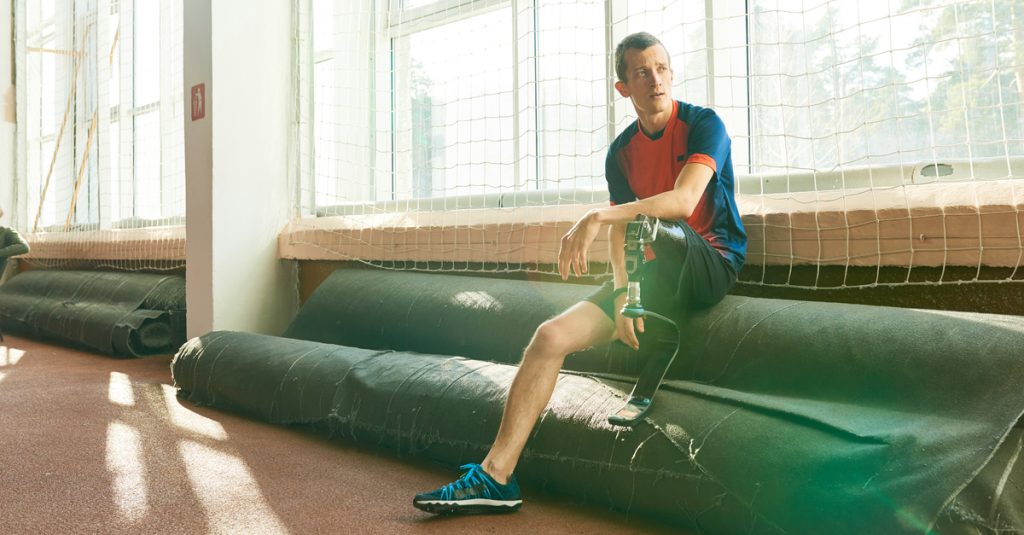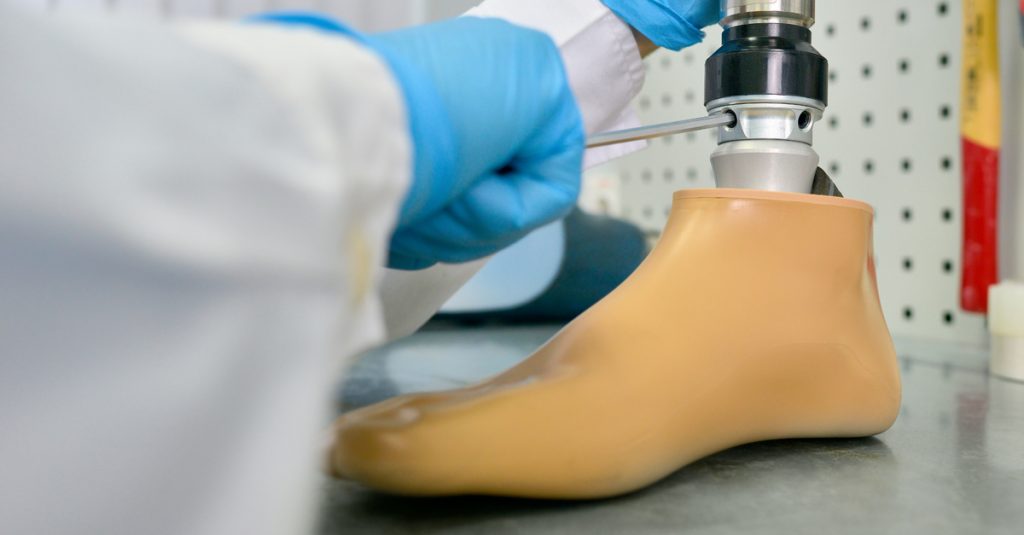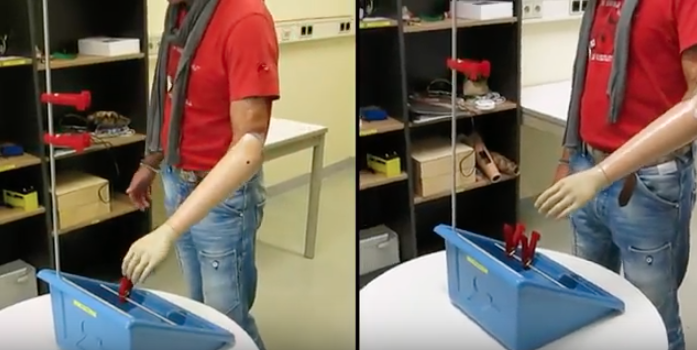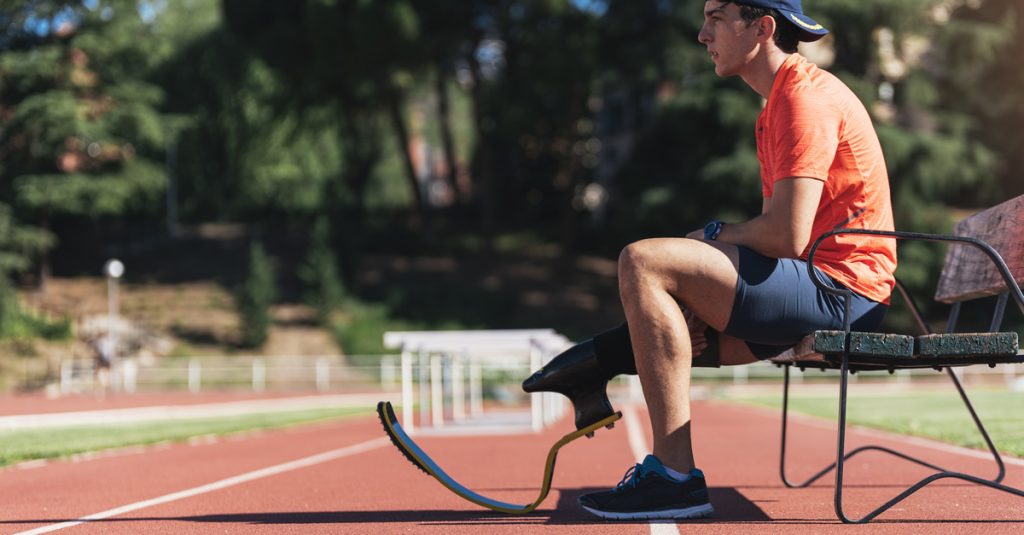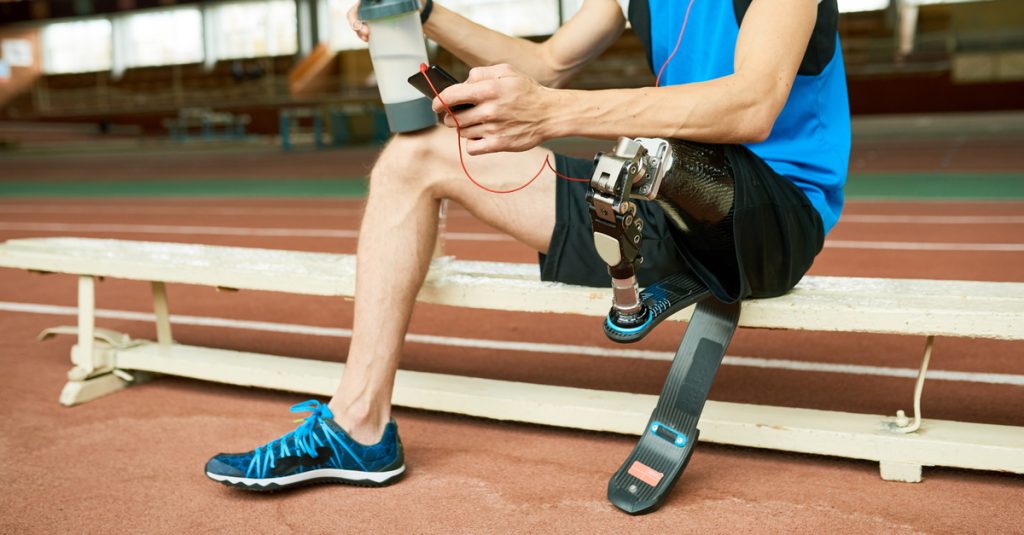Prosthetic technology has come a very long way, even over the past decade. The trend now is trying to find a way to give the sensation of feeling to amputees through high-tech prosthetic devices, especially artificial arms and hands.
Researchers in France may have come up with the latest innovation: technology that lets amputees “feel” like their prosthetic limb is a part of their own body.
How Phantom Limbs Hold the Key
Some amputees dislike wearing their prosthetic devices because they feel like the device doesn’t “fit” their phantom limb.
And yet, the sensation of a phantom limb may hold the key to giving a sensation of feeling to an amputee through an artificial limb.
That’s what researchers at a university in France believe. They recognized that the prosthetic limbs currently on the market do not give a sense of touch to the wearer. The only “feelings” are what the wearer sees. It can be difficult to operate the limb unless the wearer is actively looking at it.
The researchers are essentially training the brain to go beyond just sight and incorporate touch into how they view their prosthetic device. Through tricking the brain, scientists have helped amputees “feel” their phantom limb growing into the prosthetic device - giving them the greater sensation of touch that they have been missing.
How the Technology Works
The technology is limited so far, but what it has been able to do is striking.
The researchers stimulate nerves in the stump of the subject’s arm while the subject wears an artificial arm and hand. This sends artificial feelings to their phantom limb’s fingertips. They also equip the wearer with virtual reality goggles that show how the phantom limb is “growing” into the prosthetic device.
The end result: wearers said they felt as through the artificial hand belonged to their own body.
The technology could be put into a portable setup that can provide therapy to amputees who are struggling to adapt to his or her prosthetic device. Therapy, in conjunction with advances in hardware and software that create sensations of touch and texture, can transform the way amputees interact with their prosthetic devices - and revolutionize the industry.
BioTech designs and manufactures prosthetic limbs for people suffering from limb loss. We treat every patient with compassion and respect, and work hard to deliver superior service and prosthetic devices that change lives. Recognize your possibilities. Contact us today for more information.
Halloween is rapidly approaching, and there’s no better time to dress up as something scary and funny for what should be an entire month of festivities.
You do not want to wait until the last minute to come up with a costume. The best Halloween costumes take planning and forethought. Whether you want to amuse or horrify, you have to put in the time and get the creative juices flowing.
We decided that this year, we are going to help you get a jump on the Halloween fun by sharing with you a few great costume suggestions for people with limb loss.
Pirate Captain
Everyone loves a good pirate. And what’s something every pirate needs? A peg leg!
The essential elements of a great pirate costume are simple. You’ll need:
- An eyepatch
- A bandana or pirate hat
- A billowy white shirt
- Pants that go just past your knee
- Gold jewelry of your choice
- The infamous peg leg
Real pirate peg legs were made of wood. You could replicate wood by wrapping brown paper around your artificial leg. But you don’t have to. You can help take the pirating world into the modern day with your prosthetic leg just as it is.
You will get bonus points for your costume if you can talk like Captain Jack Sparrow from Pirates of the Caribbean. Just get lots of practice.
(Here are some pirate costume pictures to give you some inspiration.)
Scary Zombie
Everyone has seen a zombie at some point (hopefully not in real life). You can scare others this Halloween as a shambling fiend from the grave by dressing as a zombie - complete with missing limbs!
You’ll need:
- Torn clothing
- Gruesome face makeup
- Fake blood
You can go with or without your prosthetic limb. If you go without, put fake blood around your stump. If you go with, you can really impress people if you rig it so it can fall off whenever you want to put a fright in someone. If you do not want to go that far, but still want to be creepy, dress your artificial limb in the same clothes, add a little fake blood, and then carry the limb around with you as you stumble down the streets.
People will love it.
(Here are zombie costume pictures to give you a few ideas.)
Shark Attack Victim
Anyone who has ever seen Jaws knows just how terrifying a shark attack can be.
You can replicate this terror by dressing as a shark attack victim! You’ll need:
- A surfboard or boogie board
- A wetsuit OR a long-sleeved water top OR a bathing suit
- Fake blood
If you are wearing a wetsuit or a long-sleeved water top, shred the edges where your missing limb is. Put fake blood wherever the limb would be, and splatter some on the rest of you.
Then - and this is the fun part - draw and cut out a big chunk from your surfboard or boogie board in the shape of a shark bite.
Then you will be in prime position to horrify - and amuse - people you “surf” into.
What are you going to be this Halloween?
BioTech designs and manufactures prosthetic limbs for people suffering from limb loss. We treat every patient with compassion and respect, and work hard to deliver superior service and prosthetic devices that change lives. Recognize your possibilities. Contact us today for more information.
Most people do their homework when it comes to finding a doctor or a dentist. It shouldn’t be any different when looking for a prosthetist. After all, all of these professions are there to help take care of your body. You need the right prosthetic care just like you need the right medical or dental care.
But how do you find the right prosthetist for your needs? What should you look for? What kind of questions should you ask? How do you really know they’re a right fit for you?
What the Right Prosthetist Should Offer
Different prosthetists offer different things. But the best prosthetists offer:
- Decades of experience
- Dedication to patients
- Advanced prosthetic technology
- In-house prosthetic design and fabrication
- Enthusiastic providers
- Comfortable space
There are a couple of things on this list that most prosthetists can’t offer, and that’s advanced prosthetic technology and in-house prosthetic design and fabrication.
Most prosthetic providers don’t actually make their own prosthetics. They depend on other manufacturers to design, manufacture, and ship the devices to them. It’s important that your provider makes prosthetic devices in house because they’ll fit better and the process will take a lot less time, especially if you have to get your device adjusted frequently (and you will).
If they do make prosthetic devices, they need to use cutting-edge technology. A combination of laser scanning and 3D modelling with robotics ensures a better-performing, better-fitting device.
Asking the Right Questions
When interviewing the few prosthetists that you’ve narrowed down, you should ask a few important questions, such as:
- What is the process you use from start to finish to get patients fitted with the right prosthetic device?
- How do you make sure the device fits perfectly?
- If I have a problem with my device, how will you take care of it?
- What payment/insurance options do you offer?
- Are there any patients I could talk with to see how it is working with you?
You should feel free to ask any question you can think of. The right prosthetist will have the patience to answer all of them. This isn’t a decision you should take lightly, and they shouldn’t take it lightly either.
Take the time to talk to current and former patients. See what kind of care they’ve been given. Are they happy with their devices? With the service they’ve received? Would they recommend this prosthetist to one of their loved ones?
Finding the right prosthetist is a big decision. Take the time to go through the process and find a perfect fit who can give you a perfectly-fitting device.
BioTech Limb and Brace helps amputees recognize their possibilities by helping them live with a new prosthetic device. Learn more about our prosthetic fabrication and fitting services or contact us for more information.
A condition called cranial asymmetry - when your baby’s head is irregularly shaped - is more common today than it has ever been. We can trace this phenomenon back to 1992, when pediatric experts recommended that parents lay their infants on their backs to sleep, in an effort to avoid SIDS.
It worked - the rate of SIDS dropped by 40% in large part due to this shift - but the move also caused higher rates of cranial asymmetry.
Fortunately, the three types of cranial asymmetry - brachycephaly, plagiocephaly, and scaphocephaly - can be corrected with parenting techniques and cranial remodeling.
Here’s what you need to know about cranial remodeling to see if it’s a good fit for your infant.
Discussing Cranial Asymmetry
There are three different types of cranial asymmetry that can happen to your infant, as discussed above.
Brachycephaly is also called flat head syndrome, because a part of the baby’s skull is flat. This usually means the back of the baby’s head is flat, due to a practice of sleeping on his or her back for extended periods of time. It also results in a wider and taller head than normal.
Plagiocephaly can include flat surfaces, but it also includes distortion so that the baby’s head looks like a parallelogram if you’re looking at the top of the baby’s head. One ear may be more forward than the other, and one eye may be smaller than the other.
Scaphocephaly is caused by premature fusion of two or parts of the skull and can result in a long, narrow head.
Surgery may be required to treat some of these conditions - particularly scaphocephaly - but fortunately, cranial remodeling with cranial orthoses can correct them.
How Cranial Remodeling Works
Cranial remodeling works to reshape your baby’s head because a baby’s skull is very pliable compared to an adult skull. That’s why it gets deformed in the first place. The good news is that if it can be deformed, it can be reformed as well.
What we do is scan your baby’s head with a digital laser scanner - don’t worry, it’s perfectly safe and harmless - and upload the measurements into our 3D modeling system. From there, we design and create a foam-based cranial orthotic helmet that your baby will wear.
Your baby has to wear this all day, every day, except for when he or she is being bathed and when the helmet is being cleaned. Ideally, your infant will wear this sometime between three months and 12 months of age, when we see the most cranial growth. It may take a few months of treatment - up to six months in most cases - but the end result can be very favorable if you seek intervention early.
The helmet will reshape the baby’s skull as it grows into the shape we want it to be. You’ll still need to develop good habits - such as giving baby plenty of tummy time - but the helmet will take care of the remodeling process.
The end result should be a baby with a normally-shaped head, which makes all of us happy.
If you’re considering cranial remodeling for your baby, contact us. We’ll walk you through the process and discuss with you how cranial remodeling can be a huge benefit to your baby and your family.
Your body is the only one you’ll ever have. We need to give it all the support we can so it can support us as we go through our daily lives, no matter where we are or what we’re doing. Some of us have conditions that can interfere with “normal” movement, whether it’s due to an injury or a disorder.
In those cases, we have something that can really help us in our time of need, to live life fully, with as much mobility as possible: custom orthotic devices.
How Custom Orthotics Devices Help
A custom device - whether it’s a molded plastic foot orthosis to fit your feet or a knee-ankle-foot orthosis (KAFO) for your leg - has up to three purposes:
- Ensure proper range of motion (to the fullest extent possible)
- Provide proper support for the body part
- Correct abnormal alignment or curvature
Some of these goals are accomplished by helping your body bear its weight properly, such as the case with a shoe insert orthosis. Sometimes, we want to support a weaker limb, such as a leg, by equipping it with an orthosis designed to support the leg whenever it moves (or even is still, when the person is standing).
A device can only help, though, if it’s made properly, and the only way to do that is to create custom devices.
How We Create Custom Devices
At BioTech, we take great care to precisely and exactly measure your body so that we can craft something that is a perfect fit.
We have two main methods of getting an exact fit:
- Plaster casting
- Laser scanning
Plaster casting works by measuring your body part and creating a replica of the part in plaster so that we can get exact measurements.
Laser scanning works by using sophisticated equipment to scan your body part from all angles and upload the data into our computer. From there, we use specialized software to create a 3D model.
Often, we’ll combine the two so we make sure the fit is optimal, especially for more complicated situations.
The end result is an orthosis that fits you like a glove - which is the only way that a device can properly support you and accomplish the goals of the orthosis.
The next time you need an orthotic device, talk to a specialist provider who takes great care to create a custom-fitted piece just for you.
BioTech designs and creates custom orthotic devices for adults and children with a variety of conditions. Contact us if you have questions or want to schedule an evaluation.
The holy grail of the prosthetic device world is a device that acts just like a natural limb through the thought processes of its user.
These “smart” devices aren’t here yet, but researchers are hard at work, and some of what they’ve come up with is pretty amazing compared to where we were only a decade ago.
The latest advance that is helping prosthetic device manufacturers and researchers is machine learning.
Machine Learning: Teaching Computers How to Think and Learn
Machine learning uses artificial intelligence to teach a computer how to “learn” - or get to a point where it can do new functions without having to be programmed to do those specific tasks.
By using this process, researchers and developers can get a computer to learn, as they go, how to better utilize data inputs and convert them into outputs. Put another way, the computer learns how to take what it’s being given and turn it into an action - and each time they do this, the process gets faster and more efficient until the actions are natural.
Developing Prosthetic Devices with AI
What researchers are doing is taking machine learning concepts and using them to develop computers and sensors that can take signals from a patient’s brain via electrodes on their stump and convert them into commands to their electronic prosthetic devices - and get better and better until the movement is natural.
A video created by the Applied Surgical and Rehabilitation Technology Lab at the University Medical Center Göttingen in Germany shows how machine learning and AI helped create a prosthetic hand that is much more natural and smooth than the current models, which have slower, jerkier motions.
In the video, you can see a dramatic difference in performance as a user performs a simple task with the smart prosthetic hand versus current models without machine learning.
Technology is improving all the time. We talked previously about how researchers are developing prosthetic limbs that have the sensation of touch. By using machine learning and advanced sensors, developers can replicate touch and natural movement to create artificial limbs that one day will function virtually as well as our natural ones.
Contact us to learn more about prosthetic devices and let us share how we can help you live a normal and fulfilling live with your prosthetic limb.
Scoliosis is a fairly common condition of the spine that is usually found in childhood. Roughly three million cases of scoliosis are diagnosed each year, and many of them appear around the ages of 10 to 12.
Scoliosis is usually mild to moderate, but there can be severe cases that cause disability and immobility. Fortunately, medical science has come a long way over the past decades, and treatment for scoliosis has become more effective.
Here’s what parents need to know about childhood scoliosis and scoliosis treatment.
It’s Important to Get Diagnosed Early
The best chance to treat scoliosis is to diagnose it early. If you can identify the condition before your child hits a major growth spurt, you can begin corrective procedures that can mitigate the spinal curvature as much as possible.
Your children should attend regular checkups. If they exhibit any symptoms of scoliosis, such as uneven shoulders and hips, one shoulder blade being more prominent than the other, or an uneven waist, seeing the doctor becomes even more important.
Scoliosis Can Be Hereditary
Did you know that scoliosis can run in the family? Many people aren’t aware of the often hereditary nature of scoliosis. If someone in your family has had it, chances are your children are vulnerable to it as well.
A lot of times, parents don’t expect scoliosis because they think no one in their family had it. But there’s a good chance that it was a mild case or went undiagnosed.
Treatment Is Available
Only about a third of all cases require treatment, and only a tenth of cases require surgery to correct the curvature, and this is in cases of deformity or immobility.
In those cases that require intervention, bracing is usually the go-to method. Orthotic braces specifically designed to correct curvature can be created custom to your child’s body. They’ll need regular adjustment as the child grows, especially from the age of 10 to adolescence, which means you’ll need to develop a relationship with a good orthotist who understands your child’s needs.
If your child does require surgery, good news: surgeries often are successful and have good outcomes! The usual procedure is a fusion of the spine to correct the curvature, and recovery time is typically one to two months.
Scoliosis can sound scary, but it’s very manageable, and with the right help, your child can experience a full and healthy life.
BioTech designs and creates custom orthotic braces for scoliosis patients and children with other conditions. Contact us if you have questions or want to pursue treatment for your child.
Many of our patients who use our prosthetic devices are disabled veterans who are no longer in the military due to their disability.
Many of them have expressed frustration with transitioning from the military to civilian life, which can be hard enough for a veteran who doesn’t have a disability.
But, as we’ve helped them to learn, there are plenty of opportunities available to disabled veterans who want to find a new way to use their skills and experiences.
One of the most common ways disabled veterans have gotten back in the game and realized their potential is starting their own business.
Here, we’ll talk about how starting your own business can empower you to seize the day and live the life you want - even with your disability.
Veterans Have What It Takes: Courage
The veteran patients we’ve worked with, to a person, have something that every entrepreneur needs: courage.
Courage isn’t an absence of fear; it’s acting in the presence of it. And there’s a lot to fear when you’re starting your own venture, just like there’s a lot of fear when you face life with a disability.
What you’ll realize is that you have courage, and this courage is a must-have trait for a would-be businessperson. Courage is what will keep you moving forward even though the path seems intimidating and you may not be sure where you’re going or what you’re doing.
Courage sustains, not just in business, but in living life as a disabled veteran.
Veterans Know the Value of Teamwork and Leadership
You may have been in a leadership position when you were in the military, but even if you weren’t, you were part of a team and understand how teamwork and leadership go hand in hand to achieve a mission.
These traits are very difficult to find in the workforce among people who didn’t serve. Employers will pay a premium to find a hard-working team member, let alone a leader. As a veteran, you have an advantage.
Even if you don’t start your own business, you can parlay your experiences as a dedicated team member to the workforce. There is an employer out there who’d love to have you.
And if you are starting your own business, you’ll be able to put together a strong team because you know what it takes to get the job done when it comes to people.
The Government Will Help You
As a veteran, you will have preference for government contracts if you start your own veteran-owned small business (VOSB). A lot of veteran business owners have benefitted from this preference.
As a disabled veteran, you will get even more preference because you can qualify as a service-disabled veteran-owned small business (SDVOSB).
All of this comes with more opportunity for grants, loans, and other sources of funding to help get your business off the ground.
Above all, realize that life doesn’t end with the beginning of a disability. It’s just beginning. Your next journey is at hand, and it can be whatever you want it to be. Don’t let your disability get you down. See it as an opportunity to recognize the possibilities that lie before you - and seize them with courage, boldness, and determination.
BioTech helps disabled veterans with prosthetic devices, giving them the tools and support they need to live the life they want. Contact us for more information.
For those who have suffered from limb loss, the idea of a prosthetic device can be intimidating. No one plans on wearing one until they need one, and even when they need one, they may need to understand how it works before they get comfortable with the idea.
We run into this all the time and field a lot of questions from our patients about how their prosthetic legs and arms work - how they’re designed, how they’re supposed to fit and function, etc.
Here, we’ll break down how the components of your prosthetic device are supposed to work and make you more familiar with the design so that when it comes time to move, you’re ready to go.
Factors Behind Your Design
Not all prosthetic limbs are created the same. What you get depends on a few factors, such as:
- Body type
- Type of amputation
- Upper extremity
- Below elbow
- Lower extremity above the knee
- Below the knee
- Your body type
- The size, shape, and strength of the residual limb
- Your lifestyle
But generally speaking, prosthetic legs have the same function, as do prosthetic arms. They may just take different avenues to deliver that function.
The Components of Your Prosthetic Device
The most important component of a prosthetic arm or leg is actually the one you can’t see from the outside: the socket.
The socket is important because prosthetic devices have to be worn. You’re going to put a lot of pressure on that residual limb, and if the socket doesn’t fit right, it’ll cause a lot of pain and discomfort.
That’s why we go to great lengths to ensure a perfect fit for the socket, including molding, robotic carving (which is the most accurate fabrication process in the field), and 3D laser scanning.
It’s important to note that your residual limb will change over time. So, the socket has to be updated in order to match the contours of your body. The goal is a comfortable fit, which is something you absolutely should expect. No prosthesis should hurt when you wear it.
Other components include the joints. If you have an above-the-knee amputation, you’ll have two joints: the knee and the ankle. That doesn’t mean you’ll have an ankle that swings; sometimes it’s a fixed position that attaches the foot device to the leg itself. But your knee joint will be designed to allow the leg to naturally swing forward.
Knee and ankle joints (as well as elbow joints for upper extremity devices) can be computerized as well, which means a computer remotely controls the swing of the device as well as the shock absorption when you use it.
Finally, you may have a foot or hand attachment that can range from very basic to fully functional. Research is currently being done to expand the abilities of modern-day prosthetic devices to deliver functionality as close to biological capability as possible.
Now that you’re more familiar with your prosthetic device, you can begin the fulfilling process of getting fitted for your device and starting to learn to move and thrive in it.
BioTech helps amputees recognize their possibilities by designing and constructing comfortable and functional prosthetic devices. Contact the team for more information on your device and how you can take the next steps forward toward the rest of your life.
If you’re new to limb loss, you probably have a lot of questions, concerns, uncertainties, and doubts. That’s normal - it’s a tough thing to get used to, one that’ll take time and effort.
We’ve worked with countless patients who have come to us after limb loss frustrated, dejected, and confused. Over the years, we’ve amassed a lot of knowledge and guidance that has helped our patients make the big adjustment and go on to live normal lives.
Here are four tips that can help you move forward, both practically and mentally.
How Do I Choose a Prosthetic Provider?
Your prosthetic device will be one of the most important things to helping you recover and get back to normal. It has to fit right, function well, and be a good match for you. The same goes for the people who make it.
A prosthetic provider, ideally, is someone who makes you feel comfortable and at ease. You’ll need to build a relationship with your prosthetist, so it makes sense to look for a place where you feel at home.
You’ll also want the best technology and the best outcomes. Ask about their devices and how they make them. Talk to previous and current patients to learn from their experiences.
Your prosthesis won’t be a good fit unless your prosthetist is a good fit.
Adapting to Wearing a Prosthesis
A lot of our patients have difficulty with envisioning how it’ll be to wear a prosthesis. It can be overwhelming, but in reality, adapting is easier than you think, with the right guidance.
One issue that comes up involves pain and discomfort. Our patients frequently ask us if wearing a prosthesis will hurt. The answer is simple: no, it shouldn’t, not if it’s designed the right way! Your body will change and adjust over time, and we’ll have to adjust your device to match, but you shouldn’t feel pain when wearing your prosthesis.
You may need rehab or physical therapy to get used to your prosthesis, especially if it’s an artificial leg, but practice makes perfect. All you have to do is work with your prosthetist and follow his or her instructions and keep at it. You will get used to it with a bit of time and patience.
There are also exercises and training you can do to strengthen your body and practice the mechanics of moving around with your prosthesis that can really help.
Coping with Phantom Limb Pain
As an amputee, you may experience phantom limb pain, which is pain or other sensations coming from where the brain thinks your limb used to be. Even though the limb isn’t there, the brain still processes signals from the body that it often interprets as pain.
Phantom limb pain can range from uncomfortable to very unpleasant. There’s no way to predict how severe it will be or when it will occur. Sometimes it lasts for a few seconds, other times it lasts for significantly longer.
Fortunately, you can treat it. There are ways to help patients cope with phantom limb pain that include everything from deep brain stimulation to non-opiate analgesics for pain management.
Read this post on phantom limb pain to learn more about these methods and what you can do.
Adjusting Is All About Learning
We won’t tell you that as an amputee, you can do anything you put your mind to, just like a person with all of his limbs. That’s not true - you will have to adjust, and there will be things that are more difficult for an amputee to do.
But that’s okay, because as you get practice and experience, you can learn ways to do just about anything you want.
Living after limb loss is about finding ways to do things you want to do with whatever works, while understanding that you don’t have to do things like you used to be able to do. It’s healthy to say to yourself, “This will be hard at times and I’m going to have to be a bit creative, but I can figure it out.”
Whether it’s getting in and out of the shower or carrying a load in your arms while walking on your prosthetic leg, you’ll eventually develop systems and habits to function and get around. You’ll train your brain and your body at the same time, and you’ll learn - and with learning comes a more normal life.
Don’t think you have to be the same as a “normal” person. You just have to be you and do things your way. Take pride in being different and in solving puzzles that other people don’t have to face. You’ll feel a sense of accomplishment that other people will never understand.
Life doesn’t end at limb loss - it’s just beginning. Talk to us about getting a prosthetic device and taking the first steps forward in the newest part of your journey.
